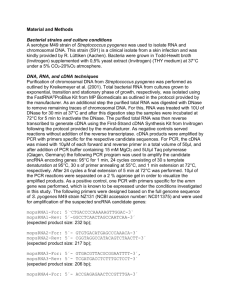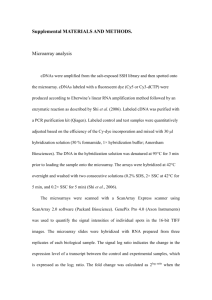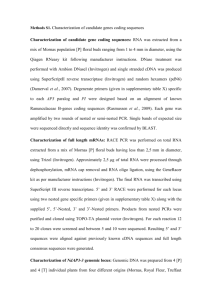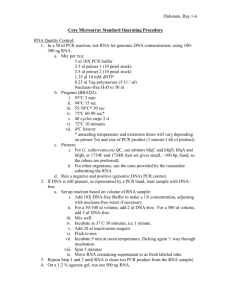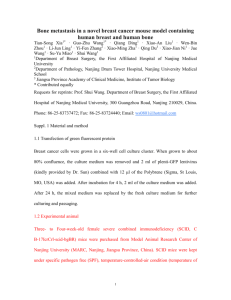The Postprandial Functional Genomics of the Python Heart
advertisement
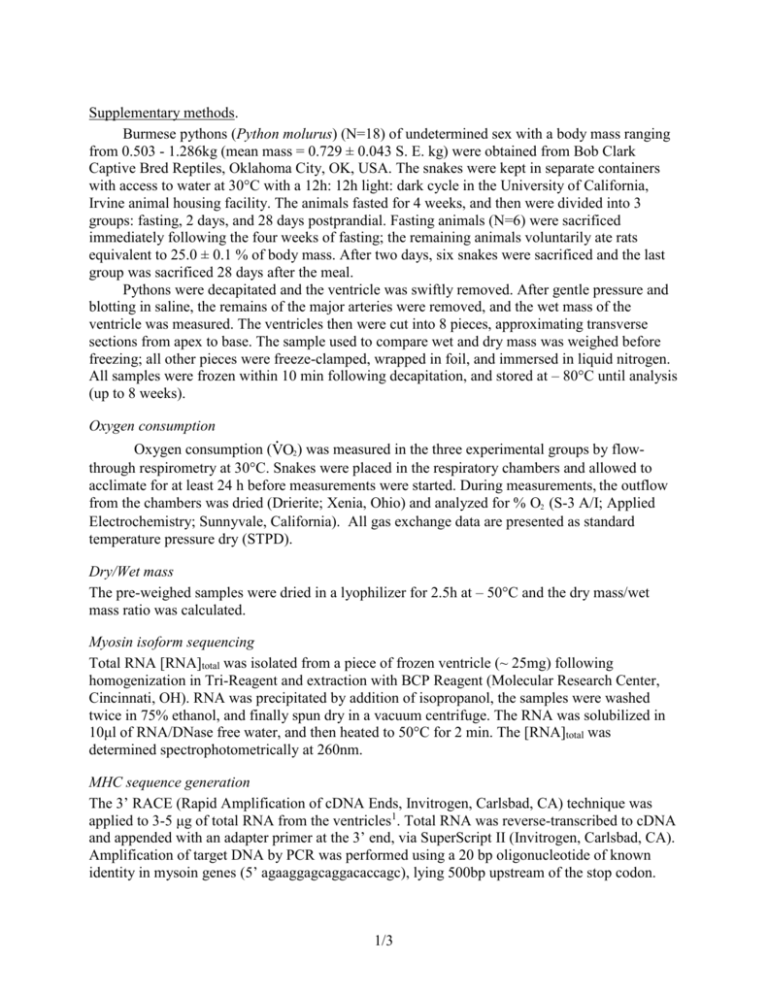
Supplementary methods. Burmese pythons (Python molurus) (N=18) of undetermined sex with a body mass ranging from 0.503 - 1.286kg (mean mass = 0.729 ± 0.043 S. E. kg) were obtained from Bob Clark Captive Bred Reptiles, Oklahoma City, OK, USA. The snakes were kept in separate containers with access to water at 30°C with a 12h: 12h light: dark cycle in the University of California, Irvine animal housing facility. The animals fasted for 4 weeks, and then were divided into 3 groups: fasting, 2 days, and 28 days postprandial. Fasting animals (N=6) were sacrificed immediately following the four weeks of fasting; the remaining animals voluntarily ate rats equivalent to 25.0 ± 0.1 % of body mass. After two days, six snakes were sacrificed and the last group was sacrificed 28 days after the meal. Pythons were decapitated and the ventricle was swiftly removed. After gentle pressure and blotting in saline, the remains of the major arteries were removed, and the wet mass of the ventricle was measured. The ventricles then were cut into 8 pieces, approximating transverse sections from apex to base. The sample used to compare wet and dry mass was weighed before freezing; all other pieces were freeze-clamped, wrapped in foil, and immersed in liquid nitrogen. All samples were frozen within 10 min following decapitation, and stored at – 80°C until analysis (up to 8 weeks). Oxygen consumption Oxygen consumption (VO2) was measured in the three experimental groups by flowthrough respirometry at 30°C. Snakes were placed in the respiratory chambers and allowed to acclimate for at least 24 h before measurements were started. During measurements, the outflow from the chambers was dried (Drierite; Xenia, Ohio) and analyzed for % O2 (S-3 A/I; Applied Electrochemistry; Sunnyvale, California). All gas exchange data are presented as standard temperature pressure dry (STPD). Dry/Wet mass The pre-weighed samples were dried in a lyophilizer for 2.5h at – 50°C and the dry mass/wet mass ratio was calculated. Myosin isoform sequencing Total RNA [RNA]total was isolated from a piece of frozen ventricle (~ 25mg) following homogenization in Tri-Reagent and extraction with BCP Reagent (Molecular Research Center, Cincinnati, OH). RNA was precipitated by addition of isopropanol, the samples were washed twice in 75% ethanol, and finally spun dry in a vacuum centrifuge. The RNA was solubilized in 10μl of RNA/DNase free water, and then heated to 50°C for 2 min. The [RNA]total was determined spectrophotometrically at 260nm. MHC sequence generation The 3’ RACE (Rapid Amplification of cDNA Ends, Invitrogen, Carlsbad, CA) technique was applied to 3-5 μg of total RNA from the ventricles1. Total RNA was reverse-transcribed to cDNA and appended with an adapter primer at the 3’ end, via SuperScript II (Invitrogen, Carlsbad, CA). Amplification of target DNA by PCR was performed using a 20 bp oligonucleotide of known identity in mysoin genes (5’ agaaggagcaggacaccagc), lying 500bp upstream of the stop codon. 1/3 The PCR (Robocycler, Stratagene, La Jolla, CA) was carried out on 1 μl of cDNA in 25 μl of PCR reaction buffer2. The resulting 600-700bp fragments, containing MHC isoforms and other potentially unrelated sequences, were eluted from 1.5% agarose-TAE gels (Qiagen, Valencia, CA) into 35 μl of water. The eluted sequences were ligated (Rapid DNA Ligation Kit, Roche, Indianapolis, IN) into a pGEM-T vector (Easy Vector System, Promega, Madison, WI). Two μl of each cDNA sample were added to a cocktail with 1 μl of ligase, following the manufacturer provided protocol. Ligation proceeded for 30 min at room temperature, followed by termination at –20 °C. Competent DH5 cells (Invitrogen, Carlsbad, CA) then were transformed (2 μl of the resulting ligation reaction with 50 μl of cells) on ice for 30 min. The cells were briefly heat-shocked (37°C), then added to LB medium and incubated for 1 hour at 37 °C. Cells were collected by centrifugation and were plated for 14h on LB-medium agarose plates containing 100 g/ml ampicillin and X-gal. Colonies containing the DNA insert were incubated overnight at 37 °C, in 3ml LB-medium and ampicillin. Plasmid DNA was extracted by MiniPrep (Qiagen, Valencia, CA), and sequencing reactions (~200 total, bi-directional using SP6 and T7 primers) were performed using ABI Prism BigDye (Applied Biosystems, Foster City, CA) and HalfBD Enhancer reagent (Genetix, Charlestown, MA). Sequences were analyzed on an ABI Prism 3100 capillary sequencer (UCI-DNA Core Facility). MCH sequence analysis and semi-quantitative RT-PCR Sequences of ~600bp, representing the last ~500bp of each gene, and an additional 50-100bp of the 3’ untranslated region, were compared by BLASTn analyses (NCBI) to other myosin sequences. Two sequences were identified as putative cardiac MHC isoforms. Identity as specifically α or β could not be resolved; however, each was uniquely obtained from either atrial or ventricular tissue. Primers for the ventricular isoform were identified by eye, utilizing the higher variability in the 3’ untranslated region; these were modified in length to conform to a common annealing temperature of 55°C. A multiplex PCR reaction was performed on the individual ventricular samples; each reaction was comprised of the MHC common primer, the ventricular isoform-specific primer, and primers for the 18s ribosomal subunit together with a competing primer (10pmol/μl, 55°C annealing temperature)1,2. Care was taken to ensure that the PCR reaction was in the linear range by comparison with reactions of fewer or greater cycle numbers. Northern blots and hybridization. These measurements were accomplished as previously described2. Briefly, approximately 5 µg of total RNA were electrophoresed in 0.8% agarose gels in a buffer containing 8% formaldehyde, 20 mM 3(N-morpholino)-propanesulfonic acid, 5 mM sodium acetate, and 0.5 mM EDTA, pH 7.0. The RNA was transferred to a quiabrane (Quiagen) nylon membrane by the capillary method using 10× saline-sodium citrate and subsequently covalently cross-linked to the nylon membrane by UV light (UV crosslinker, Fisher Scientific). After drying at 80°C for 1 h to evaporate the formaldehyde, blots were stored at 4°C until used for hybridization. For hybridization, the 5’ antisense oligonucleotides used above for the PCR reaction was used. Hybridization with the probe, washing, and exposure to the autoradiographic film was done simultaneously for 3 samples from each group. Intensity of the bands was determined through autoradiography, and then the probes were washed off the blots by boiling for 10-15 min in 1% SDS. The blots then were rehybridized with a general MHC probe to verify equal hybridization and gel loading. Autoradiograms were analyzed by laser-scanning densitometry (Molecular Dynamics). 2/3 References 1. Rourke, B.C., Qin, A., Haddad, F., Baldwin, K.M. & Caiozzo, V. J. Appl. Physiol. 97, 1985-1991 (2004). 2. Wright, C., Haddad, F., Qin, A.X. & Baldwin, K.M. J. Appl. Physiol. 83, 1389-1396 (1997). 3/3




